Pamphlet Books
Pamphlets are books with a single section and an easy-to-stitch binding. This form has the advantage of looking like a slim version of a codex book, without the complicated binding.Tools:
- scissors
- pencil
- ruler
- cutting mat
- needle
- awl
- 1 piece heavy-weight cover paper (the same size or slightly larger - a half inch to an inch in each dimension - than the page paper)
- double-sided page paper (size depends on the page size)
- heavy thread - pearl cotton embroidery floss works well (amount depends on stitching)
- Beads, etc. to decorate the stitching
- Deckle-edged cutter
Designing the Pages
Pamphlets have pages in increments of four - two on each side of a sheet of paper. The paper is folded in half to make the pages of the book. The left diagram below shows one side of a sheet. The width of a page will be half the width of the sheet (green). The height of the page will be the height of the paper (blue). The right diagram below shows the side divided into pages. |
 |
|
| One Side of a Sheet | Pages on One Side |
|---|
The sheets will need to be trimmed once they are stitched, since they tend to fan out from the center. The inside edge of each page will be partially hidden by the stitched edge, so it's important to allow plenty of margin space on all sides of a page. Generally, a half-inch around each of the outside edges and an inch between the two pages is the minimum margin. The only exceptions are the two center pages and the front and back outside cover, both of which will have the stitching down the middle, but otherwise could be printed as one page.
The cover paper will have one side containing the outside back cover on the left and the outside front cover on the right, and the other side containing the inside front cover on the left and the inside back cover on the right, as shown below.

The top of the page is the same direction for all four pages on a sheet of paper. The layout of the rest of the book depends on the number of pages. The number of pages a pamphlet can hold depends on the thickness of the paper, but numbers greater than about 80 (about 20 sheets of paper) are impractical for binding in a pamplet, even for very thin paper. If the book does not have a number of pages divisible by four, blank pages need to be inserted in the book. The calculator below inserts blank pages at the back to bring the total to a multiple of four. To put the blank pages elsewhere, include them in the page numbering of the book.
For an example of how the table works, it has been filled in for 17 pages. The first sheet of paper will have a blank page on the left and page 1 on the right of the first side. On the second side of that sheet, page 2 will be on the left and another blank page on the right. The top of the page is the same direction for all pages on a sheet. The second sheet of paper will have a one side with a blank page on the left and page 3 on the right and the other side with page 4 on the left and page 17 on the right. Overall, this book would require five sheets of paper plus the cover sheet.
Assembling the Book
After printing the pages, assemble them in order. The easiest way to do this is to pick up the cover and set it down with the inside pages on top. Take the sheet that has page one and place it on top of the cover so page one faces the inside front cover. Page two will now be facing up on the left. Take the sheet that has page three and place it on top so that page three faces page two. Page four will now be facing up on the left. Continue until all the sheets are placed. Fold each sheet in half width-wise so that the book will open and close correctly and reassemble the pages.In order to stitch the binding, the sheets need to have holes punched in them along the spine. If the cover sheet is the same size as the page sheets, it can be punched at the same time, otherwise measure and punch it separately. Mark five equally spaced holes along the spine. Take the stack of paper and make sure all the sheets are aligned. Place the stack cover side up on the cutting mat and use the awl to punch the holes.
After punching the holes, the book can be stitched. The amount of thread needed is approximately three to ten times the height of the sheet, depending on how many times the stitching pattern is repeated and whether or not beads or other decorations are added. When in doubt, cut the thread long. While stitching, take care not to rip the holes, but pull the thread as taut as possible. Too much give in the binding will leave the pages unsupported. The stitching pattern is as follows:
| An edge-on view of the book with the five holes punched in the spine. The cover is on the top of the diagram and the top edge of the book can be either left or right. |
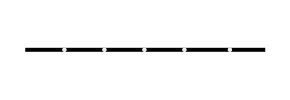 |
| Step 1: Starting from the cover side of the book, push the needle through the middle hole and leave a tail long enough to tie a knot. |
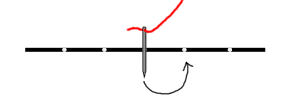 |
| Step 2: Push the needle up through the inner-right hole. |
 |
| Step 3: Push the needle down through the outer-right hole. Beads can be added on this step to decorate the spine. |
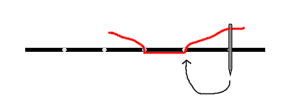 |
| Step 4: Push the needle up through the inner-right hole. |
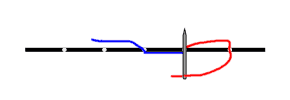 |
| Step 5: Push the needle down through the inner-left hole. Beads can be added on this step to decorate the spine. |
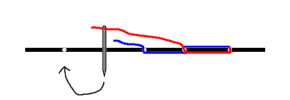 |
| Step 6: Push the needle up through the outer-left hole. |
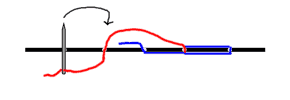 |
| Step 7: Push the needle down through the inner-left hole. Beads can be added on this step to decorate the spine. For a stronger binding, repeat steps 2 through 7 (black arrow) two to four times, depending on the thickness of the thread. To finish, go to step 8 (green arrow). |
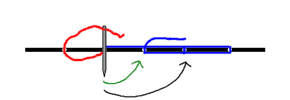 |
| Step 8: Push the needle up through the middle hole. |
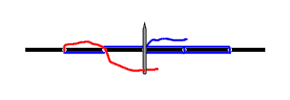 |
| Step 9: Tie a knot with both ends of the thread.< |
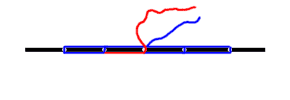 |
Refold the stitched book and flatten it. Since the sheets fan out from the center, they need to be trimmed with the scissors to make them more even and to keep them inside the cover sheet. Alternatively, a deckle cutter can be used to create a deckled edge on the pages. If the cover sheet is larger than the pages, trimming may not be necessary.



